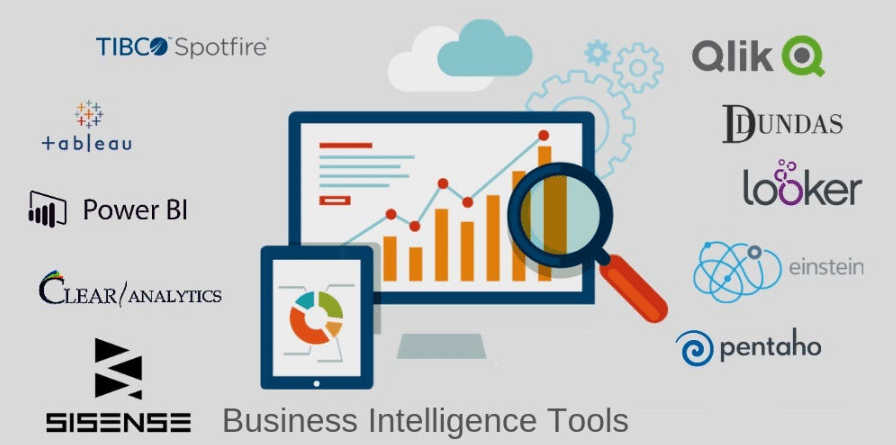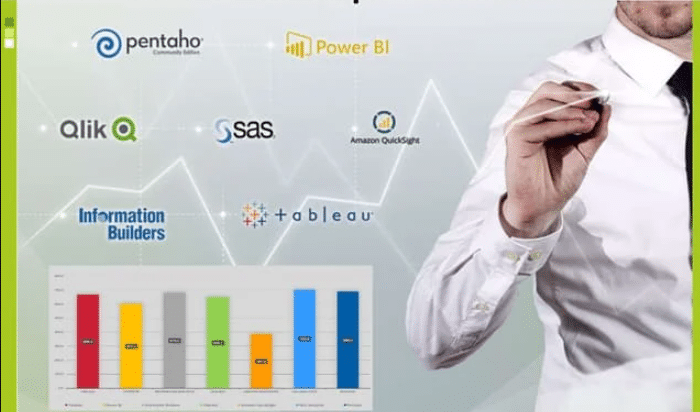The Business Intelligence Tools You Need to Know
The Business Intelligence Tools You Need to Know, refers to the technologies, processes, and practices that organizations use to collect, analyze, and present data in a meaningful way to facilitate informed decision-making and drive business performance. BI involves transforming raw data into actionable insights and visualizations that provide a comprehensive view of an organization’s operations, customers, and market trends.
BI leverages a combination of data analytics, data visualization, and reporting techniques to transform complex data into understandable and meaningful information. It enables organizations to gain valuable insights, identify patterns, trends, and correlations, and make data-driven decisions to improve operational efficiency, optimize processes, and achieve strategic objectives.
Top Business Intelligence Tools You Need to Know

There are several Business Intelligence (BI) tools available in the market that offer a range of features and capabilities. Here are some popular BI tools that you should know:
Microsoft Power BI
Power BI is a widely used and user-friendly BI tool that enables users to connect to various data sources, create interactive visualizations, and share insights across the organization. It offers robust data modeling capabilities, advanced analytics features, and seamless integration with other Microsoft products.
Tableau
Tableau is a leading data visualization and BI tool known for its intuitive interface and powerful visual analytics capabilities. It allows users to create interactive dashboards, reports, and charts without the need for complex coding. Tableau supports data connectivity to various sources and offers a wide range of visualization options.
QlikView and Qlik Sense
QlikView and Qlik Sense are popular BI tools known for their associative data modeling, allowing users to explore data dynamically and make discoveries. They offer interactive dashboards, self-service data exploration, and collaborative features. Qlik Sense is more focused on self-service analytics and enables users to create their own visualizations.
SAP BusinessObjects
SAP BusinessObjects is a comprehensive BI suite that provides a range of tools for reporting, ad-hoc analysis, and data visualization. It offers integration with SAP and non-SAP data sources, enabling users to create interactive dashboards, reports, and predictive models.
IBM Cognos Analytics
Cognos Analytics is a powerful BI tool that offers features for reporting, data exploration, and advanced analytics. It provides a user-friendly interface, AI-powered insights, and supports both cloud and on-premises deployments. Cognos Analytics also integrates with other IBM products.
Oracle Analytics Cloud
Oracle Analytics Cloud is a cloud-based BI platform that offers a wide range of capabilities, including data visualization, self-service analytics, and augmented analytics. It integrates with Oracle and non-Oracle data sources and provides advanced AI-driven insights and data preparation features.
These are just a few examples of BI tools available in the market. Each tool has its own strengths, user interfaces, and pricing models. It is important to evaluate your specific requirements, data sources, scalability needs, and budget before selecting a BI tool that best fits your organization’s needs.
Is Excel a Business Intelligence Tools?

Excel can be considered as a basic Business Intelligence (BI) tool, although it may not possess the full range of advanced features offered by dedicated BI tools. Excel has built-in functionalities that allow users to perform data analysis, create reports, and generate basic visualizations. It is widely used in organizations for data manipulation, calculations, and simple data modeling.
Excel’s BI capabilities include features such as data sorting, filtering, pivot tables, and basic charting options. These functionalities can help users analyze data, identify trends, and gain insights. Excel also allows users to connect to external data sources, perform calculations, and create custom formulas to perform complex analyses.
However, Excel may have limitations when it comes to handling large and complex datasets, real-time data integration, advanced statistical analysis, and interactive visualizations. Dedicated BI tools often provide more sophisticated capabilities, such as advanced analytics, data modeling, predictive modeling, interactive dashboards, and collaboration features.
Excel can be a valuable tool for small-scale data analysis, ad-hoc reporting, and basic BI requirements. It is widely accessible, familiar to many users, and can serve as an entry point to understand data analysis concepts. However, as data volumes and complexity increase, and as organizations require more advanced analytics and visualization capabilities, they often turn to specialized BI tools that offer more comprehensive features and scalability.
Ultimately, the suitability of Excel as a BI tool depends on the specific needs, budget, and complexity of the data analysis requirements within an organization. It can be a useful starting point for basic BI needs, but as organizations grow and require more sophisticated BI capabilities, they may explore dedicated BI tools that provide a broader range of features and functionalities.
Best Kind of Tools in Excel
Excel is a spreadsheet software tool developed by Microsoft. It is part of the Microsoft Office suite of applications and is widely used for data organization, calculations, analysis, and reporting. Excel provides a range of features and functionalities that enable users to work with numerical data, create formulas, perform calculations, and generate visualizations.
Some of the key features and capabilities of Excel include:
Data Entry and Organization:
Excel allows users to enter, edit, and organize data in a tabular format. It provides tools for formatting data, applying styles, and managing worksheets.
Formulas and Functions:
Excel offers a wide range of built-in mathematical, statistical, and logical functions. Users can create custom formulas to perform calculations, manipulate data, and derive insights.
Data Analysis and Manipulation:
Excel provides features such as sorting, filtering, and data validation that help users analyze and manipulate data. It also supports data importing and exporting from various file formats.
PivotTables and PivotCharts:
PivotTables in Excel allow users to summarize and analyze large datasets. They provide a powerful way to aggregate data, create cross-tabulations, and generate insightful reports. PivotCharts enable users to visualize data in various chart formats based on PivotTable results.
Visualizations and Charts:
Excel offers a range of chart types, including bar charts, line charts, pie charts, and more. Users can create visually appealing charts to present data in a clear and understandable manner.
Data Connectivity:
Excel allows users to connect to external data sources, such as databases, web services, and other file formats. This enables data integration and analysis using data from multiple sources.
Collaboration and Sharing:
Excel provides collaboration features, such as track changes, comments, and co-authoring, that allow multiple users to work on the same workbook simultaneously. Users can also share Excel files with others for viewing and editing purposes.
Macros and Automation:
Excel supports the creation of macros, which are recorded sequences of actions that can be replayed to automate repetitive tasks. Macros can help users save time and increase productivity.
Excel is a versatile tool that can be used for a wide range of tasks, including financial modeling, budgeting, data analysis, project management, and more. It is widely adopted across industries and is popular due to its user-friendly interface, familiarity, and broad functionality.
